

 Vol. 38 (Nº 62) Year 2017. Páge 32
Vol. 38 (Nº 62) Year 2017. Páge 32
Rakhila RAKHMETOVA 1; Karlygash ZHAKENOVA 2; Kulzada ABENOVA 3; Maira RYSKULOVA 4; Regina ANDEKINA 5
Received: 06/10/2017 • Approved: 05/11/2017
2. Identifying a research problem
ABSTRACT: Currently, there are no special studies in Kazakhstan covering the issues of the urban economy theory along with a comprehensive assessment of the urbanization process in the Republic in terms of industrial and innovation development. The problem of detailed study of Kazakhstan cities, needed to form the policy of its further integration into the general system of world cities, is currently poorly understood. The ambitious targets of our country's entering in the list of 30 highly-developed countries, assigned by the President N. A. Nazarbayev, directly depends on the sustainable development of Kazakhstan cities, since due to the existing potential, cities can provide quality "breakthroughs" in the development of the national economy and in other spheres of public life. This problem is highly relevant for modern Kazakhstan. In the course of the work on the project, the authors have made an overview of the general structure of the conceptual apparatus of the theory of city economy designed to study the nature, structure and laws of urban evolution. In accordance with the objectives set, the authors have carried out a fundamental analysis of the theory of city economy, which includes a spatial analysis of the urbanized territory, constituting an essential part of the city economic science, a review of the international experience in monitoring of the cities' socio-economic development from the point of view of urban (public) infrastructure development. We have also examined the development of the city's economy in the context of globalization, identified the specific features of development of Kazakhstan's cities, and analyzed the international experience in the development of urban economies with a view to their comparison with the specific features of development of Kazakhstan's cities. Furthermore, we have conducted research to identify the phenomena and processes characterizing specificities (socio-economic) of Kazakhstan cities and evaluated their development potential. The results of this study are presented in this article. For this purpose, we have classified the cities according to their major characteristics using such method of multidimensional statistical analysis as cluster analysis. The resulting grouping made it possible to classify cities based on their: population, demographic, production and social characteristics. The obtained results allow improving the competitiveness of Kazakhstan cities and regions. |
RESUMEN: Actualmente, no hay estudios especiales en Kazajstán que cubran los temas de la teoría de la economía urbana junto con una evaluación integral del proceso de urbanización en la República en términos de desarrollo industrial y de innovación. El problema del estudio detallado de las ciudades de Kazajstán, necesario para formar la política de su mayor integración en el sistema general de las ciudades del mundo, es actualmente poco conocido. Los ambiciosos objetivos de ingreso de nuestro país en la lista de los 30 países altamente desarrollados, asignados por el Presidente NA Nazarbayev, dependen directamente del desarrollo sostenible de las ciudades de Kazajstán, ya que debido al potencial existente, las ciudades pueden proporcionar "avances" de calidad en el desarrollo de la economía nacional y en otras esferas de la vida pública. Este problema es muy relevante para el Kazajistán moderno. En el curso del trabajo sobre el proyecto, los autores han hecho una revisión de la estructura general del aparato conceptual de la teoría de la economía de la ciudad diseñada para estudiar la naturaleza, la estructura y las leyes de la evolución urbana. De acuerdo con los objetivos establecidos, los autores han llevado a cabo un análisis fundamental de la teoría de la economía urbana, que incluye un análisis espacial del territorio urbanizado, que constituye una parte esencial de la ciencia económica de la ciudad, una revisión de la experiencia internacional en el monitoreo del desarrollo socioeconómico de las ciudades desde el punto de vista del desarrollo de la infraestructura urbana (pública). También hemos examinado el desarrollo de la economía de la ciudad en el contexto de la globalización, identificado las características específicas del desarrollo de las ciudades de Kazajstán y analizado la experiencia internacional en el desarrollo de las economías urbanas con miras a compararlas con las características específicas del desarrollo de las ciudades. Ciudades de Kazajstán Además, hemos llevado a cabo investigaciones para identificar los fenómenos y procesos que caracterizan las especificidades (socioeconómicas) de las ciudades de Kazajstán y hemos evaluado su potencial de desarrollo. Los resultados de este estudio se presentan en este artículo. Para este propósito, hemos clasificado las ciudades de acuerdo con sus características principales utilizando dicho método de análisis estadístico multidimensional como análisis de conglomerados. La agrupación resultante permitió clasificar las ciudades en función de su: población, demografía, producción y características sociales. Los resultados obtenidos permiten mejorar la competitividad de las ciudades y regiones de Kazajstán. |
Currently in the CIS (Commonwealth of Independent States) space, insufficient attention is paid to the problems of city economy. One of the studies to be mentioned in this direction is the research work conducted by the Institute of Urban Economics (Russia). Since 1995, its experts have carried out a number of studies and consulting projects in various areas of the urban economy in more than 100 Russian cities. One of the drawbacks of many studies is that they don’t fully consider the issues of city economic development. City economy represents the problems of local public goods, providing a spatial specification of public sector analysis.
Being a complex system of human life management, the city is studied in the framework of interdisciplinary research. Each of these branches of science constantly improves, enriches and fills the concept of the "city" with a new content.
Both in Russian and Western European science, a certain tradition has developed, which was defined as "the philosophy of the city", "the history of the city", "the anthropology of the city", "the cultural development of the city" and "the sociology of the city". The city is now considered not only as a populated place where industry, commerce and power institutions are functioning, but as a living organism with its history, rise and fall, diseases and revivals, or even as a "super organism", something similar to a human person with its soul, face and destiny, since the city is a mirror which reflects and captures all the major cultural processes taking place within society. Moreover, the city itself adds its own specific problems, studied by a full range of urbanistic sciences.
Thus, the city is a specific spatial environment, which is a social and spatial form of public existence, physically and socially organized life environment and a certain social community. City develops according to the laws of interaction between large groups and under the laws belonging to different branches of science and spheres of life activity, such as architecture and town planning, economics, culture, ecology, ethnography, political science, history, geography and so force. Each of the spheres is provided with knowledge from the corresponding theoretical or applied scientific discipline. Therefore, when studying the city, it is necessary to apply a systematic approach that allows considering the city as a complex system, as well as studying its internal processes (Elokhov, 2011; Dubrov, Mkhitaryan, & Troshin, 2009; Dubrova & Rakhmetova 2011; Khalafyan 2007).
Currently, it becomes undeniable that the future of humanity depends entirely on the city development. In this regard, the study of the socio-economic development of cities is a matter of great interest. This interest is attributable to a number of circumstances. First, city is the location of production, financial, human, information flows and the center of innovation development. Secondly, cities are the centers of economic, political, social, demographic and cultural processes development. Thirdly, the sustainable development of the state is impossible without the sustainable development of its cities.
According to various sources, now 50% of the world's population lives in cities. According to the forecasts of the United Nations and the Organization for Economic Cooperation and Development (OECD) experts, by 2050 the population of cities will reach 70-80% (A New Round of Urban Development in Kazakhstan, 2015).
Therefore, we consider it appropriate to start grouping cities’ potentials with the analysis of state programs aimed at development of territories.
The predictive scheme for spatial development of the country until 2020 says that "in modern conditions, space and location are no longer considered as the secondary public policy factors; instead, they have become an important factor of socio-economic development of the country. Such factors as the growth of cities and agglomerations, the increased mobility of population, the development of trade and services, which have been catalysts for progress in developed countries over the past two decades, are now considered the driving forces for the developing countries" (Predictive Scheme for Territorial and Spatial Development of the Country until 2020, 2011).
The Republic of Kazakhstan occupies the ninth biggest territory in the world. Its length is 2724.9 thousand kilometers. 87 cities are located in this large territory. About 57% of the country's population is concentrated in the cities, along with the majority of enterprises, organizations, scientific and educational centers.
18 of 31 small cities in Kazakhstan specialize in processing of agricultural products. The rest focus on:
According to the JSC "DAMU" Entrepreneurship Development Fund, 11 Kazakhstan cities demonstrate the best conditions for development. Meanwhile, the cities of Derzhavinsk in the Akmola Region, Zhem and Temir in the Aktobe Region, Sergeevka in the North Kazakhstan Region show low development potential (List of small Towns and Monocities in the Republic of Kazakhstan, n.d.).
In terms of sectoral orientation, the monocities of Kazakhstan are distributed as follows:
Just as throughout the world, Kazakhstan's cities are assigned the central role in the development of innovations and economic growth. Cities should pave the way to the latest knowledge and technologies. However, as it is mentioned in the State Program of Industrial-Innovative Development of the Republic of Kazakhstan for 2015-2019, the following problems remain:
The Program defines the cluster policy that will be aimed at transferring the economy to a new technological platform. In the course of its implementation, as stated in the Program, two innovation clusters in the "new economy" sectors will receive government support: the "Nazarbayev University" cluster in Astana and the "Park of Innovative Technologies" cluster in Almaty.
In 2015, the National Program for Infrastructure Development "Nurly Zhol" for 2015-2019 came into effect. (Approved by the Decree of the President of the Republic of Kazakhstan dated April 6, 2015 No. 1030).
The state program is aimed at creating a "unified economic market by integrating the country's macro-regions based on building an effective infrastructure on the hub principle to ensure Kazakhstan's long-term economic growth, as well as implementation of anti-crisis measures to support certain sectors of economy in the face of the worsening situation in the foreign markets". It is assumed that hub cities will become centers of economic activity in macro-regions, concentration of capital, resources, advanced technologies and services and become the attraction points for migratory flows, thus creating conditions for natural urbanization. Other large cities of macro-regions or second-tier cities will be linked to the hub city on the "radial" principle. According to the Program, " the development of hub cities and integration of macro regions will be ensured based on effective development of transport, industrial, housing, social and energy infrastructures. These changes will cause a significant demand for building materials, industrial products and equipment, and will contribute to the development of the manufacturing industry". The list of hub cities at both national and international levels includes the cities of Almaty, Astana, Aktobe, Shymkent and Oskemen (The State Program of Infrastructure Development "Nurly Zhol" for 2015-2019, 2015).
Thus, the analysis of state programs shows that urbanization of Kazakhstan will continue through creation of urban agglomerations and hub cities, which will lead to a more active resettlement of the rural population. In our view, this will be a long-term process, which will continue till the standard of living in rural areas will become closer to that in the urban areas.
To group the cities on socio-economic grounds for development, we have carried out a multidimensional classification, based on the main cities' characteristics with the use of statistical and mathematical methods. For cluster analysis based on their development potential, we have used "STATISTICA/7-9/" package.
Based on the results of cluster analysis, Kazakhstan cities can be combined into similar, closely related groups. This classification allows classifying cities in terms of population, demographic, production, social and other characteristics.
Statistical indicators of social and economic development were collected for 87 cities. However, due to the lack of unified statistical indicators, we have selected only 43 of 87 cities for grouping – where we managed to collect the most important socio-economic indicators.
To determine the general state of the social and economic development of cities, we used 14 indicators that characterize cities according to the following socio-economic characteristics: population, thousand people (end-of-year); total fertility rate; balance of migration (people); total mortality rate; subsistence minimum (on average per capita) in tenge; industrial production (million tenge); retail turnover (million tenge); investments in fixed assets (million tenge); average monthly wage (tenge); number of active small and medium enterprises (SMEs in units); industrial production per 1 city resident; retail trade volume per 1 city resident; investment per industrial production; the number of active enterprises; the number of SMEs per 1 city resident.
To determine the social and economic potential of cities, the authors used variations for several groups of factors. Classification in different variants considered different combinations of factors.
In the first variant, classification of cities was grouped into four clusters. Thus, the first cluster comprised 12 cities, which included the large city of Almaty, 5 other large cities and regional centers, 4 monotowns, 1 small town. The second cluster comprised 20 cities, including 1 large city – Shymkent, 5 regional centers (Aktobe, Uralsk, Taldykorgan, Aktau, Kokshetau), the cities of Semey and Turkestan, 8 monocities (Zhanaozen Zhezkazgan, Kentau Khromtau, Kurchatov, Karazhal, Satpayev, Arkalyk) and 3 small towns (Priozersk, Arys, Shalkar). The third cluster included 8 cities, generally the so-called monotowns: Temirtau, Shakhtinsk, Saran, Lisakovsk, Rudny, Tekeli cities, Kapshagai town and the regional center Petropavl.
We have started to analyze clusters from the smallest, the fourth cluster. It includes three big cities: Astana, Atyrau, Aktau. According to the data received (Figure 1), the smallest cluster, comprising of three cities, demonstrates high rates of social and economic growth in all ten factors. These cities show the best indicators compared with the cities of the first, second and third clusters. This cluster comprises cities with impressive development potential.
Astana is the center of attraction of human capital. The city's population is constantly increasing due to migration flows from other regions and neighboring countries. The employment rate of the economically active population is 94.5%.
Figure 1
The ratio of the average values for 10 cluster characteristics
to the corresponding average values for the sample
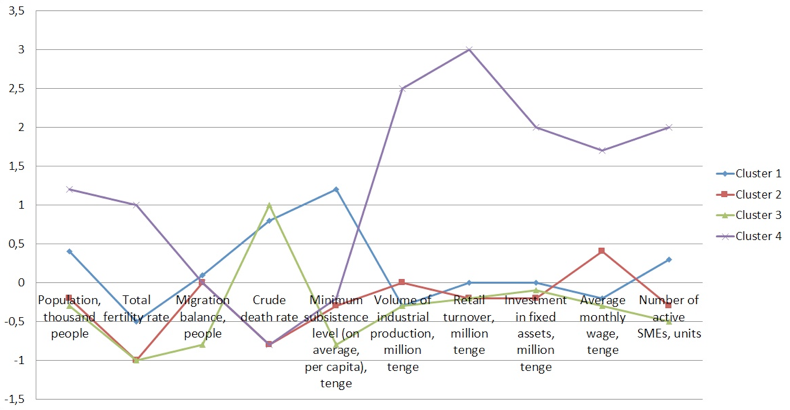
According to the results obtained, it can be assumed that the city of Karaganda is also dynamically developing. All the indicators demonstrate the growth trend. For example, the average monthly salary for January-December 2015 was 115,859 tenge (1 US dollar approximately equals 330 tenge), which is 3.6% higher than in 2014. The population increased by 5.4 thousand people in 2015 compared to the previous year. There is a positive trend in all sectors.
Atyrau also demonstrates good development potential. Being the oil capital, the city continues to support the national economy. Meanwhile, indicators for the first cluster cities show some disproportion. Thus, with a relatively high level of subsistence minimum, the birth rates are low and death rates are high. The cost of living is higher than that in the fourth cluster. The southern capital of Kazakhstan, Almaty, was also included in the first cluster. It shows below the average numbers in the volume of industrial production, retail turnover, investment in fixed assets, average monthly wage and the number of active SMEs. A similar disproportion picture is observed in the second cluster cities. With a high birth rate and a low death rate, its population is below the average. The volume of industrial production and the wage levels is higher than that of the cities of the first cluster, while the indicators for SMEs' activity are lower.
Third cluster cities demonstrate a low level of social and economic development. This cluster comprises basically small and single-industry towns. The results obtained once again demonstrate a difficult situation in single-industry towns of Kazakhstan, with one or several similar enterprises, which determine the standard of living for the local population. As a rule, these cities have a greater dependence on the city budget, a certain remoteness from large settlements and a homotypic population due to their professional specialization. All these factors limit the labor mobility and lead to a lower employment diversification.
To determine the economic potential, which is a combination of resources and factors defining the production level and thus influencing the level of its socio-economic development, the authors used the following indicators: total fertility rate; total mortality rate; industrial output (billion tenge); retail turnover (billion tenge); investment in fixed assets (billion tenge); average monthly salary (thousand tenge); number of active SMEs (units).
With this variation, the cities were grouped into three clusters. According to the results obtained (Figure 2), the best results were shown by the second cluster cities. As with the previous classification, this cluster included the cities of Astana, Atyrau and Karaganda. These cities show the highest indicators for retail trade turnover, which is one of the most important macroeconomic indicators of the city's socio-economic development and an important factor in ensuring sustainable economic growth. Its volumes, structure and dynamics are among the main features of domestic trade.
Figure 2
The ratio of the average values for 7 cluster characteristics
to the corresponding average values for the sample
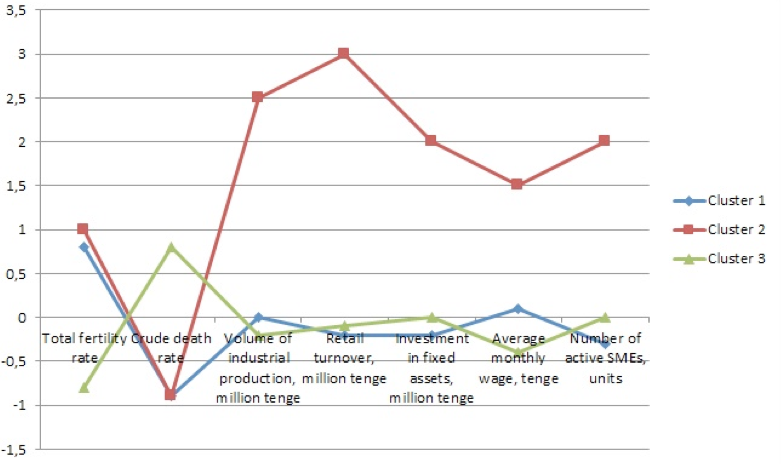
Industry is the leading sector of the national economy. If we consider the fact that the growth of industrial production in Kazakhstan is unstable, high indices of industrial output for these cities reflect the economic growth. In this respect, Astana city demonstrates the best indicators. The northern capital is the leader in the production of metal products, ready-to-use concrete, concrete itself and building materials from concrete, metal structures, radiators and central heating boilers, as well as underground transport equipment.
According to Figure 2, in terms of the fertility-mortality ratio, these cities show a favorable demographic situation. This fact indicates stabilization of life of these cities' residents. Demographic situation is, above all, the reaction to the social and economic situation of the city. The data on industrial production and retail turnover confirm this statement. These indicators are much higher than those of the other two clusters. Compared to other cities, they show higher performance in terms of investment in fixed capital, average monthly wage and the number of operating enterprises.
First cluster cities show positive demographic dynamics. This is the largest cluster in this variation. It included 30 cities. These cities also demonstrate high fertility and low mortality rate. However, in terms of other factors the indicators are significantly lower than those of the second cluster cities. 7 of the first cluster 17 cities are large cities, such as Almaty and Shymkent.
Third cluster cities demonstrate a complex demographic situation. This cluster comprises 10 cities, generally small towns and mono-cities and 2 large cities – Taldykurgan and Turkestan. Third cluster cities show the lowest birth and the highest mortality rate. We can assume that high mortality rates can be explained by a number of reasons: first, the aging of population in these cities, secondly, the worsening of social conditions and the standard of living, thirdly, the poor quality of medical care, and, finally, the deterioration of the ecological situation and the outflow of youth population. A low birth rate, in our opinion, is a direct reflection of the socio-economic situation in these cities. This cluster shows the lowest figures for the volume of industrial production and monthly wage. However, there are prospects for successful development. Based on the analysis results, these cities demonstrate positive activity of SMEs, which, in our opinion, is due to the support of mono-towns by the Government in the framework of the State Program for the Development of Mono-cities for 2012-2020.
To determine the development of small and medium-sized businesses and their impact on the level of wages, we have selected three indicators: population (per thousand people); average monthly salary (tenge); the number of active SMEs (units). The cities were also grouped into three clusters.
Figure 3
The ratio of the average values for 3 cluster characteristics
to the corresponding average values for the sample
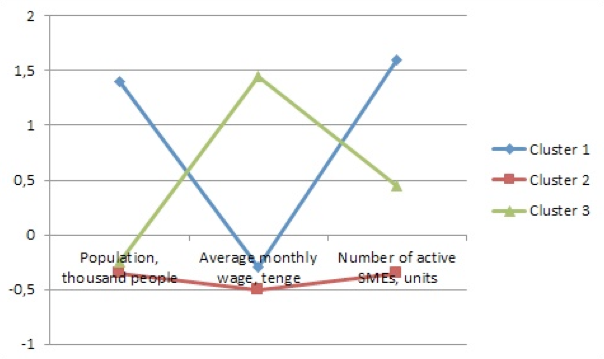
The second cluster turned out to be the most numerous cluster – it included 24 cities, mainly small and single-industry cities and several administrative centers such as Petropavl, Uralsk, Aktau, Kokshetau and Shymkent. The third cluster united eleven cities: three administrative centers – Atyrau, Taraz, Turkestan and 9 small and mono-cities. The first cluster united eight cities. In terms of composition, this is the most significant cluster, since it includes such cities as: Astana, Almaty, Karaganda, Aktobe, Kyzylorda, Oskemen, Kustanay, Pavlodar.
Figure 3 shows clear disproportions in the first and the third cluster. Thus, with a fairly high population in the first cluster cities (which included million-people cities Almaty and Astana) and with a solid number of active SMEs (mainly in Astana, Kostanay, Karaganda, Kyzylorda, Pavlodar, Oskemen, Aktobe) the wage level is below the average. The disproportion observed in this cluster is a reflection of the low standard of living in most of the cities in this cluster.
The disproportion of the third cluster cities is expressed otherwise. Thus, with a small population and small number of active SMEs, the level of wages is rather high there. In most cities in the third cluster, the population is below the average (with the exception of Atyrau, Turkestan and Taraz). The number of active SMEs is below average, except for Taraz and Atyrau. This cluster shows the highest wage level, especially in Atyrau. These are quite expected results. Oil industry still holds the leading position in the national economy, while Atyrau is the oil capital of Kazakhstan. Satpayev mono-town also demonstrates positive numbers. The city is located in the Karaganda region. Its development potential is referred to the average. The city specializes in mining and manufacturing industry.
The second, the most numerous cluster, reflects the real situation of small and single-industry towns. Their population rate is below the average, except Semey. All those cities, without exception, show below the average level of wages and the number of active SMEs. The data reflect rather low standard of living for the population of these cities.
To determine the economic activity of these cities, we have selected five groups of indicators: industrial production (million tenge); retail turnover (million tenge); investments in fixed assets (million); average monthly wage (tenge); number of active SMEs (units). The results are reflected in Figure 4.
In this classification, the cities were divided into three clusters. The first cluster united 30 cities, the second cluster – 3 cities and the third cluster – 10 cities.
The second cluster cities show the highest economic activity. As observed earlier, this cluster unites Astana, Atyrau and Karaganda, which are the leading cities on all indicators. The lowest economic activity falls on the cities grouped in the first and third cluster. Eight cities of the first cluster, such as Pavlodar, Shymkent, Aktobe, Uralsk, Kyzylorda, Oskemen, Kustanai and Aktau, show indicators above the average for the number of active SMEs, slightly above the average investment in fixed assets in the cities of Petropavl, Kyzylorda, Temirtau. For all other indicators, their results are below the average. The inhabitants of the third cluster cities have the highest salaries in the country.
Figure 4
The ratio of the average values for 5 cluster characteristics
to the corresponding average values for the sample
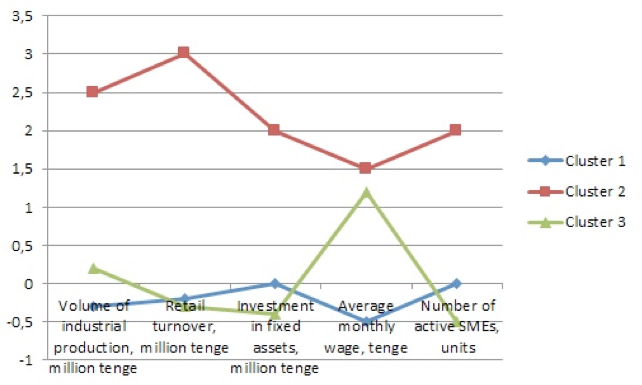
It should be noted that the residents of single-industry towns with an average development potential receive above the average wages. These are the cities of Balkhash, Karazhal, Satpayev in the Karaganda Region and Kurchatov in the East Kazakhstan Region. All these cities specialize in mining and manufacturing industry.
To determine the socio-economic sustainability of the cities, we used indicators on eight grounds: total fertility rate; crude death rate; minimum subsistence level (on average, per capita), tenge; average monthly wage (tenge); SMEs per 1 citizen; production per 1 citizen; retail 1 citizen investment per production. The results obtained are shown in Figure 5.
With the given classification, the cities were also divided into three clusters. The first cluster combined 17 cities, the second – 17 cities and the third one – 9 clusters. The third cluster cities show the highest economic activity. This cluster comprises Astana, Shymkent, Aktau, Aktobe, Zhanaozen, Atyrau, which are the "leaders" by all indicators. Meanwhile, first cluster cities (Almaty, Karaganda, Balkhash, Aksu, etc.) demonstrate the highest indicators for the development of small and medium-sized businesses per capita, industry development and investment activity. Citizens of the third cluster cities have the highest level of wages.
Figure 5
The ratio of the average values for 8 cluster characteristics
to the corresponding average values for the sample
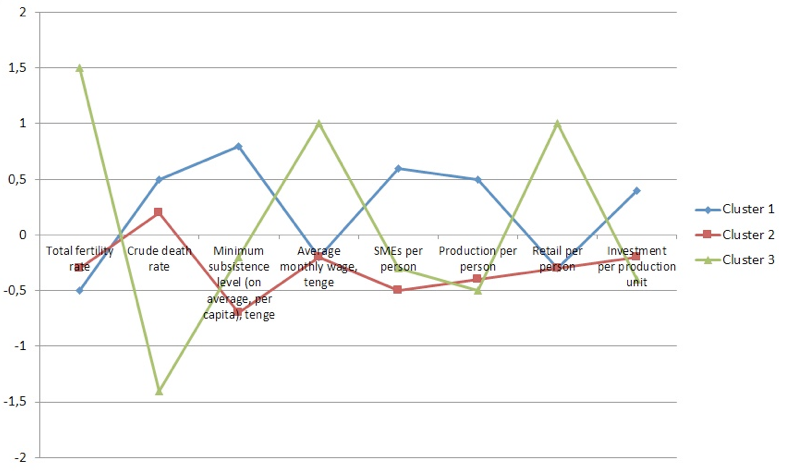
The cluster analysis has identified the socio-economic potential of forty-three Kazakhstan cities. The list includes large cities like Astana, Almaty, Shymkent, administrative centers and big cities along with small towns and mono-towns. It allowed identifying cities with a high level of economic development – Astana, Karaganda, Atyrau. They demonstrate sustainable economic growth and have great potential for further development. In a number of cities there is activity in small and medium business. Thus, out of 43 cities surveyed, 12 or 28%, demonstrate SMEs' activity above average. It can be concluded that these cities have a high development potential.
Cluster analysis has also revealed the unevenness and disproportions in the economy of a number of cities. For example, with a fairly high population and solid performance in terms of the number of active SMEs, there might be a low level of wages and vice versa.
The analysis has revealed a rather complex social and economic situation of the population in most cities. It is alarming that in 26 cities of 43 (60%), the birth rate is below the average, and the overall mortality rate in 23 cities is above the average, which is 53.4% of the total number of cities analyzed. In 24 cities out of 43, the subsistence minimum is below the average. This is more than half. Furthermore, the wage level is of even greater concern. Thus, in 31 of 43 examined cities, this indicator is below the average, which is 72%.
Today Kazakhstan city is not only a cultural and educational center, but also a scientific center for creation and consumption of innovations. Approximately 56% of the country's population is concentrated in the cities, along with the majority of enterprises, organizations, scientific and educational centers. The socio-economic development of the entire country depends on the successful social and economic development of its cities, since by virtue of their existing potential and potentialities, cities can provide quality "breakthroughs" in the development of economy and other spheres of public life. However, this statement is true for large and big cities only. Currently, only these cities can provide maximum services and opportunities; they play the role of organizing elements. The larger the city, the more opportunities it has to concentrate production in its territory and accordingly more opportunities to develop its own economy and the economy of the nearby cities.
The present scientific work was carried out under the grant program of the Ministry of Education and Science of the Republic of Kazakhstan No. 6442/GF4 "Prospects for the socio-economic development of Kazakhstan cities in the context of ten global challenges of the 21st century" for 2015-2017.
Dubrov, A.M., Mkhitaryan, V.S., & Troshin, L.I. (2009). Mnogomernye statisticheskie metody [Multidimensional Statistical Methods]. Moscow: Finansy i statistika. (p. 350).
Dubrova, T.A., & Rakhmetova, R.U. (Eds.). (2011). Prikladnye modeli ekonometriki [Applied Econometrics Models]. Almaty: Ekonomika. (p. 324).
Elokhov, A.M. (2011). Sistemnyi podkhod k gorodu kak obektu programmno-tselevogo upravleniya [Systematic Approach to the City as an Object of Results-Based Management]. Ars administrandi, 2. Retrieved September 1, 2017, from http://cyberleninka.ru/article/n/sistemnyy-podhod-k-gorodu-kak-obektu-programmnotselevogo-upravleniya
Gosudarstvennaya programma infrastrukturnogo razvitiya "Nurly zhol" na 2015-2019 gody [The State Program of Infrastructure Development "Nurly Zhol" for 2015-2019]. (2015). Retrieved September 1, 2017, from http://kfm.gov.kz/ru/activity/strategy-and-program/state-program-on-infrastructure-development-nurly.html )
Khalafyan, A.A. (2007). STATISTICA 6. Statisticheskii analiz dannykh [STATISTICA 6. Statistical Data Analysis]. Moscow: Binom-Press. (p. 512).
Novyi vitok gorodskogo razvitiya Kazakhstana [A New Round of Urban Development in Kazakhstan]. (2015, June 13). Retrieved September 1, 2017, from https://i-news.kz/news/2015/06/13/8042489-novyi_vitok_gorodskogo_razvitiya_kazahst.html
Nurlanova, N.K. (2013). Monogoroda Kazakhstana: problemy razvitiya i napravleniya vykhoda iz depressivnogo sostoyaniya [Monocities in Kazakhstan: Development Problems and Directions to Overcome the Depressed State]. Retrieved September 1, 2017, from ukros.ru/wp-content/uploads/2013/12/нурланова2.doc
Perechen malykh i monogorodov Respubliki Kazakhstan [List of small Towns and Monocities in the Republic of Kazakhstan]. (n.d.). Retrieved September 1, 2017, from http://www.damu.kz/3148
Prognoznaya skhema territorialno-prostranstvennogo razvitiya strany do 2020 goda [Predictive Scheme for Territorial and Spatial Development of the Country until 2020]. (2011). Retrieved September 1, 2017, from http://adilet.zan.kz/rus/docs/U1100000118
1. NARXOZ University, 050035, Republic of Kazakhstan, Almaty, Zhandosov Street 55
2. NARXOZ University, 050035, Republic of Kazakhstan, Almaty, Zhandosov Street 55
3. NARXOZ University, 050035, Republic of Kazakhstan, Almaty, Zhandosov Street 55
4. NARXOZ University, 050035, Republic of Kazakhstan, Almaty, Zhandosov Street 55
5. NARXOZ University, 050035, Republic of Kazakhstan, Almaty, Zhandosov Street 55